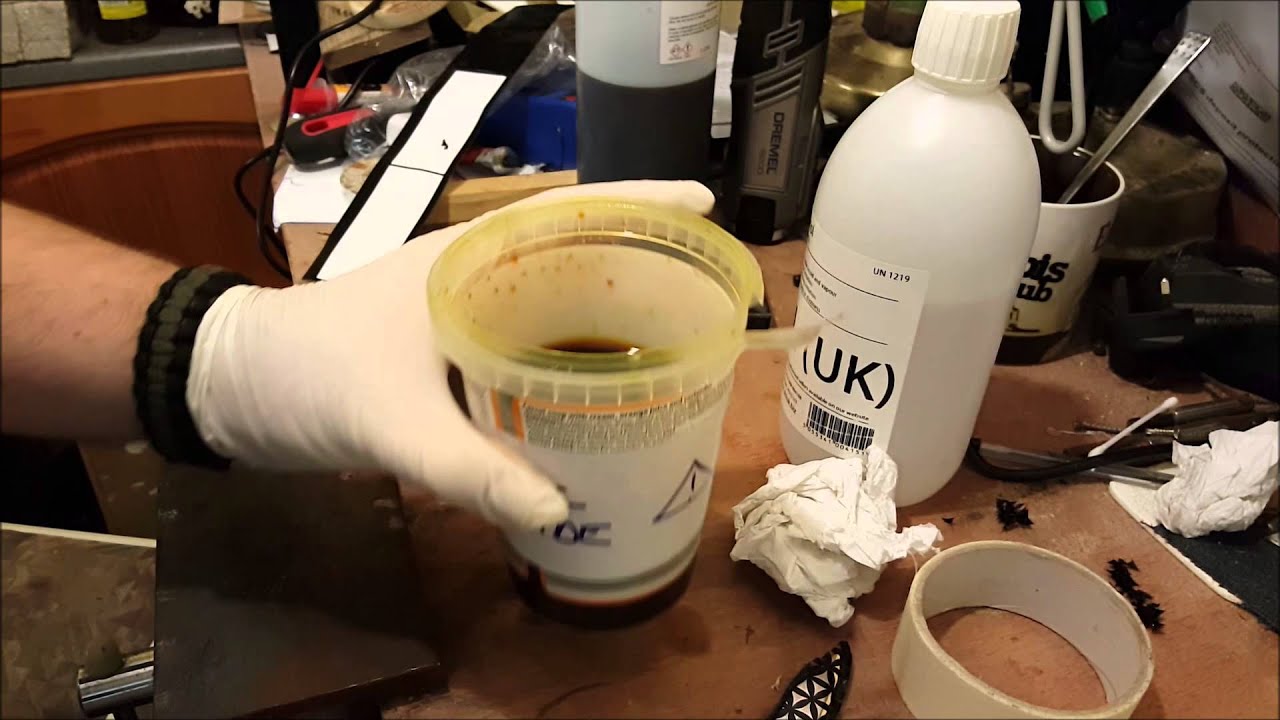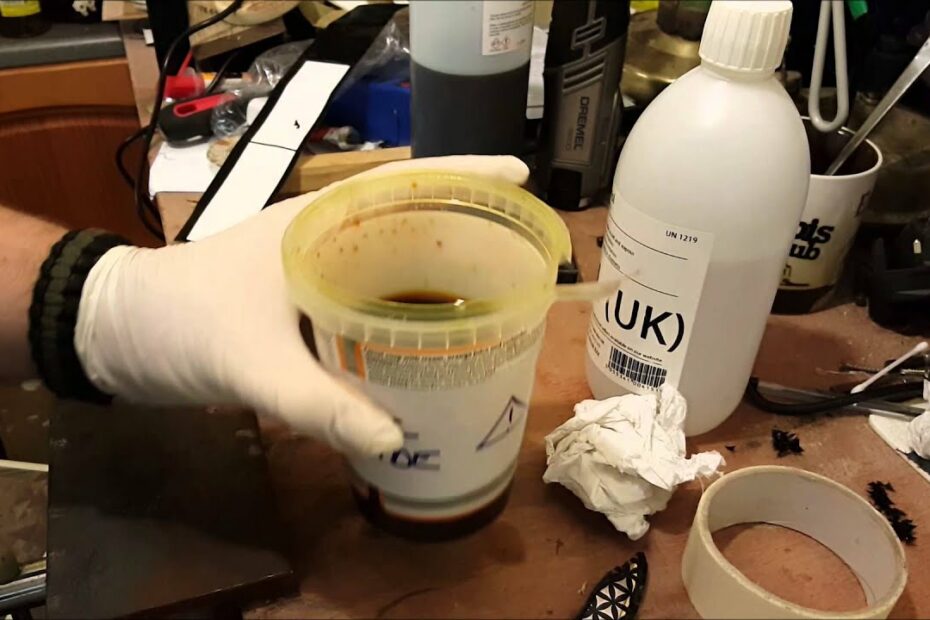Let’s discuss the question: how to use ferric chloride for etching damascus steel. We summarize all relevant answers in section Q&A of website Activegaliano.org in category: Blog Marketing. See more related questions in the comments below.

What kind of acid do you use to etch Damascus steel?
Damascus etching is completed with either ferric chloride or muriatic acid. Before you begin, check the expiration date on your acid of choice to be sure that it’s not too old.
Can you etch steel with ferric chloride?
Ferric chloride is one of the most widely used etchants in the field of chemical etching. It is commonly used to etch steel and stainless steel parts, but it is also capable of etching copper. One of the reasons it is so popular is because of its versatility.
Etching a knife with Ferric Chloride
Images related to the topicEtching a knife with Ferric Chloride

What do you mix ferric chloride with?
I mix mine 4:1 with distilled water. That’s 4 parts water to 1 part Ferric Chloride. Store it in something plastic. Add the acid to the water, not the water to the acid.
How long does ferric chloride take to etch?
Even with fresh, strong ferric chloride solution, it would usually take at least 10 minutes for the copper to be removed. As the solution grew weaker, the etch would take longer and longer.
Is ferric chloride the same as muriatic acid?
Muriatic acid is “hydrochloric acid” (HCl) in a less pure and diluted strength for non-technical applications like cleaning bricks. Ferric Chloride is an iron “salt” of HCl that is nonetheless very acidic, though not as “strong” as HCl. Either will etch any high carbon steel, eventually.
What does ferric chloride do to steel?
Chemicals that form acid in water, such as ferric (iron) chloride or copper sulfate can also be used as etching chemicals. These chemical compound work faster than acids. The strength of the acid generally determines how quickly the steel will be etched, the stronger the acid, the faster the process.
What can be used as a resist for etching?
A very quick and reliable way to cover the back of an etching plate is by applying sheets of self-adhesive film or strips of packing tape or other strong adhesive tape. In addition to protecting the back of the plate, a resist should cover the metal’s edges.
Can you etch aluminum with ferric chloride?
Ferric chloride works on copper, brass and nickel silver. It will NOT work on actual silver (fine or sterling). Do NOT use ferric chloride on aluminum. Metal as thin as 24-gauge can be etched – just leave it in for less time than you would for thicker metal.
What happens when you add water to ferric chloride?
When ferric chloride is dissolved in water the solution becomes strongly acidic as a result of hydrolysis. The chemical reactions, in words and formulae are: Schematic representation of the chemical interactions occurring during etching copper in ferric chloridesolution.
What is the pH of ferric chloride?
| Compound Formula | Cl3Fe |
|---|---|
| Boiling Point | 315° C (599° F) |
| Density | 2.90 g/cm3 |
| Solubility in H2O | 480 g/l (20 °C) |
| pH | 1.8 (6 g/l, 20 °C) |
How to mix ferric chloride (FeCl3) for etching a knife.
Images related to the topicHow to mix ferric chloride (FeCl3) for etching a knife.

Do I need to dilute ferric chloride?
Do NOT dilute ferric chloride with water. You need enough ferric chloride to completely cover your board.
What kind of acid do you use to etch a knife?
Etching acids can range from powerful hydrochloric or sulfuric acid to much weaker acids — even household vinegar, citrus fruit, or mustard can be used effectively. In the video linked above, YouTuber TheSmokinApe acid-etches an ESEE blade with French’s mustard. Yum.
How many times can you use ferric chloride?
Ferric chloride can be used more than once.
How do you make a etching solution?
Mix two-parts of diluted hydrogen peroxide with one-part muriatic acid. There you are, done! The hydrogen peroxide acts as an oxidizer allowing the acid to eat away the copper. Place your board to be etched in your new solution and watch it go!
How do you etch with hydrochloric acid?
- Acid etching involves allowing the reaction of a dilute hydrochloric acid solution with the concrete surface, then rinsing off with water. …
- Remove all dust and dirt by brooming and vacuum. …
- Add 1 part of 33% hydrochloric acid to 2 parts water to make a 10% solution.
Can you etch steel with hydrochloric acid?
Etch the design
For example, steel can be etched with hydrochloric acid, nitric acid, or sulfuric acid. Copper can be etched with ferric chloride mixed in water to form weak hydrochloric acid. Soft aluminum can be etched with ferric chloride, using acrylic polymer paint as a resist.
Can you make ferric chloride with muriatic acid?
Making ferric chloride is relatively simple. Here’s what you need: Muriatic Acid (Hydrochloric Acid) 0000 Steel Wool.
Why do you acid etch a knife?
Traditionally, most knife companies use acid etching to enhance the visual aesthetic of their differential heat treatment, or to distinguish different layers of steel in a Damascus blade.
What chemical is used in etching?
What chemical is used in etching? Most metals are etched using ferric chloride, a safe to use, recyclable etchant. Ferric chloride can be regenerated and reused. Other proprietary etchants such as nitric acid, are used for specialist metals and alloys.
HOW to FINISH and ETCH DAMASCUS steel
Images related to the topicHOW to FINISH and ETCH DAMASCUS steel

Does acid etching prevent rust?
Acid etching a knife can help improve the feel of the blade after heat treatment and prevent rust. Using the Ferric process, for example, creates the formation of a patina that slows down the formation of iron rust even though the corrosion resistance is lowered.
Why is etching stainless steel difficult?
Etching stainless steels can be somewhat difficult due to the anti-corrosive nature of stainless steel. Austenitic or 300 series stainless steels typically have higher chrome as well as a significant amount of nickel (e.g. 304 stainless steel – 18% chrome, 8% nickel) which makes them harder to etch.
Related searches
- etching damascus with hydrochloric acid
- etching damascus with ferric chloride
- etching damascus with vinegar
- how to etch damascus with ferric chloride
- how to bring out damascus pattern
- etching damascus with muriatic acid
- polishing damascus steel after etching
- etching damascus with coffee
- ferric chloride vs muriatic acid
Information related to the topic how to use ferric chloride for etching damascus steel
Here are the search results of the thread how to use ferric chloride for etching damascus steel from Bing. You can read more if you want.
You have just come across an article on the topic how to use ferric chloride for etching damascus steel. If you found this article useful, please share it. Thank you very much.

